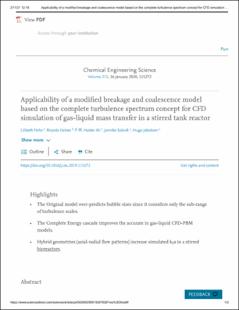Mostrar el registro sencillo del ítem
Applicability of a modified breakage and coalescence model based on the complete turbulence spectrum concept for CFD simulation of gas-liquid mass transfer in a stirred tank reactor
| dc.contributor.author | Niño, Lilibeth | |
| dc.contributor.author | Gelves, German | |
| dc.contributor.author | Ali, Haider | |
| dc.contributor.author | Solsvik, Jannike | |
| dc.contributor.author | Jakobsen, Hugo Atle | |
| dc.date.accessioned | 2021-11-02T17:18:11Z | |
| dc.date.available | 2021-11-02T17:18:11Z | |
| dc.date.issued | 2020-01-16 | |
| dc.identifier.uri | http://repositorio.ufps.edu.co/handle/ufps/602 | |
| dc.description.abstract | A generalized model for bubble breakage and coalescence is proposed using Computational Fluid Dynamics – CFD for considering the complete energy spectrum. An eulerian model and balance equations are simultaneously used to simulate the multiphase flow and bubble size distribution, respectively. The turbulent kinetic energy and its dissipation are calculated using the standard turbulence model k-ε. A semi-empirical model that solves the second-order longitudinal structure function based on an interpolation function is coupled to CFD via UDF (User Defined Functions) code. CFD results are compared with experimental data obtained from Sauter mean diameter measurements at different bioreactor positions and stirred by a Rushton turbine. A reasonable prediction is obtained in comparison with the original Coulaloglou and Tavlarides (Break up) and Prince and Blanch (Coalescence) model. Further, the generalized model was extended to other stirring and aeration geometries using the same 10 litter tank bioreactor. The latter for evaluating strategies for overcoming gas-liquid mass transfer problems commonly found in bioreactors and a significant effect of the energy spectrum is reached in the geometries studied. The above, explained by the kLa oxygen transfer rate and bubble size determinations. It is numerically demonstrated that flow patterns and bubble size significantly influence the average kLa mass transfer in a bioreactor. | eng |
| dc.format.extent | 11 páginas | spa |
| dc.format.mimetype | application/pdf | spa |
| dc.language.iso | eng | spa |
| dc.publisher | Chemical Engineering Science | spa |
| dc.relation.ispartof | Chemical Engineering Science ISSN: 0009-2509, 2019 vol:211 fasc: N/A págs: 1 - 11, DOI:10.1016/j.ces.2019.115272 | |
| dc.rights | 2019 Elsevier Ltd. All rights reserved. | eng |
| dc.source | https://www.sciencedirect.com/science/article/pii/S0009250919307626?via%3Dihub#! | spa |
| dc.title | Applicability of a modified breakage and coalescence model based on the complete turbulence spectrum concept for CFD simulation of gas-liquid mass transfer in a stirred tank reactor | eng |
| dc.type | Artículo de revista | spa |
| dc.identifier.doi | 10.1016/j.ces.2019.115272 | |
| dc.publisher.place | Australia | spa |
| dc.relation.citationedition | Vol. 211, No. 115272 (2020) | spa |
| dc.relation.citationendpage | 11 | spa |
| dc.relation.citationissue | 115272 (2020) | spa |
| dc.relation.citationstartpage | 1 | spa |
| dc.relation.citationvolume | 211 | spa |
| dc.relation.cites | Niño, L., Gelves, R., Ali, H., Solsvik, J. y Jakobsen, H. (2020). Applicability of a modified breakage and coalescence model based on the complete turbulence spectrum concept for CFD simulation of gas-liquid mass transfer in a stirred tank reactor. Chemical Engineering Science, 211, 1–11. https://doi.org/10.1016/j.ces.2019.115272 | |
| dc.relation.ispartofjournal | Chemical Engineering | spa |
| dc.rights.accessrights | info:eu-repo/semantics/restrictedAccess | spa |
| dc.subject.proposal | Bioreactor | eng |
| dc.subject.proposal | Energy spectrum | eng |
| dc.subject.proposal | Population balance | eng |
| dc.subject.proposal | KLa Gas-Liquid Mass Transfer | eng |
| dc.type.coar | http://purl.org/coar/resource_type/c_6501 | spa |
| dc.type.content | Text | spa |
| dc.type.driver | info:eu-repo/semantics/article | spa |
| dc.type.redcol | http://purl.org/redcol/resource_type/ART | spa |
| oaire.accessrights | http://purl.org/coar/access_right/c_16ec | spa |
| oaire.version | http://purl.org/coar/version/c_970fb48d4fbd8a85 | spa |
| dc.type.version | info:eu-repo/semantics/publishedVersion | spa |
Ficheros en el ítem
Este ítem aparece en la(s) siguiente(s) colección(ones)
-
Ambiente y Vida - GIAV [124]










